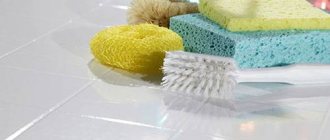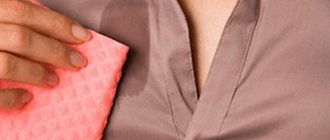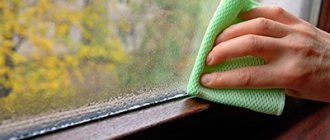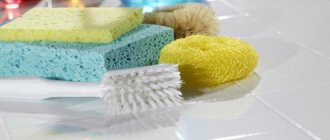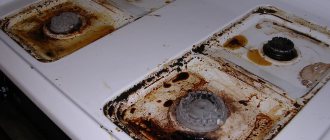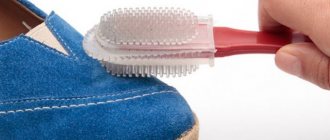After frying, cooking with oil or slicing cheeses/sausages, stains are bound to appear on kitchen tiles. If you don’t wipe them off immediately, the fat hardens, darkens and becomes very difficult to clean off.
Many housewives know that store-bought chemicals can cause allergies, and grandma’s products are not very effective. What household products can you use to avoid spending hours scrubbing shiny surfaces, and what are the best store-bought products?
Clean the tiles
First of all, you need to understand that you cannot rub tiles with abrasives, metal sponges and hard-bristled brushes. The surface will become covered with micro-scratches, darken and become untidy. As a last resort, you can use special brushes for ceramics, but it is not recommended to use them on an ongoing basis.
For washing, either soft sponges for dishes, or special brushes with very soft bristles, or ordinary microfiber cloths are suitable.
From fat and plaque
If the surface is cleaned daily and there is no heavy contamination, you can use simple recipes:
- for 2 liters of water 1 tsp. dishwashing detergent (laundry washing liquid and regular hand soap will do). Soap is dissolved in warm water, the surface is thoroughly washed, then wiped with a dry cloth;
- in 1l. dissolve a sachet (20g) of citric acid in water. The resulting solution should be applied to the tiles and left for an hour, then rinsed off.
To clean hardened grease and heavy deposits you will need “heavy artillery” - ordinary soap will no longer cope. Solutions based on soda and vinegar, professional products and hot steam will come to the rescue.
From stains and dirt
To clean the tiles in the kitchen from stains of mold or coffee/tea/juice, you can use our grandmothers’ proven remedy – ammonia. In a bucket with a capacity of 5 liters. pour a bottle of alcohol (150 ml), stir and wipe the surfaces with the resulting solution. Ideally, leave the product on for 15-20 minutes and then rinse with warm water.
Chlorine-based products perfectly remove not only stains and dirt, but also bacteria, leaving that familiar smell of cleanliness.
Reference. The most modern means of fighting dirt is a melamine sponge. Use a damp sponge to wipe away dirty stains and they disappear before your eyes without the use of any chemicals. There is no need to rinse the tiles after this.
Glossy surface
If the surface is shiny, after using standard cleaning products, the surface should be wiped with a weak solution of vinegar.
To do this, just add a spoonful of acid to 2 liters of water, shake, wipe the tiles and be sure to wipe the walls or floor dry with paper towels. After such manipulations, even previously dull tiles will become bright and sparkling.
To make the tiles shine after cleaning
After the tile has been cleaned of the layer of grease, it is advisable to restore its original shine.
To do this, wipe the surface:
- window cleaning liquid;
- tile polish or wax polish;
- ammonia diluted with water (in a 1:1 ratio).
Folk
The main components of folk recipes for preparing detergents are soda, sea salt, vinegar essence and ammonia.
By combining these simple components, you can prepare excellent, effective solutions in a couple of minutes that clean the surface well and are safe for allergy sufferers, small children and pets. If there is soda in the kitchen, there should be no question of how to wash the tiles in the kitchen.
Baking soda
The easiest way to clean tiles with stains and mold is to spray them with water from a spray bottle or wipe with a very wet cloth, sprinkle a thin layer of baking soda on top, leave for 15-20 minutes, and clean with a cloth.
There is no need to use a hard sponge, since soda itself has an abrasive effect and can even remove carbon deposits and greasy stubborn dirt.
After cleaning, the surface should be rinsed with cold water, then wiped dry with a cloth.
To prevent the appearance of odors and stains, baking soda can be left on the table, floor or apron overnight from time to time - applying it to a wet surface.
By morning it will dry out and turn into a fragile crust, which will be washed off with plain water without a trace, taking with it colored spots and greasy stains.
Soda and water
You can make a solution from water and baking soda that will help quickly remove stains, especially mold (including black mold and tiles living on the seams).
Add a tablespoon of soda (preferably natural) to 1 liter of warm water, shake and pour the resulting mixture into a spray bottle. This product is also an excellent preventative for preventing the appearance of fungus on tiles and greasy stains in the kitchen.
A paste of soda and water cleanses stains from berries, fruits and wine, as it reacts with the acid contained in these products.
To prepare it, a bowl with 250 ml. Two glasses of soda are gradually added to very hot water, and the resulting product is applied to the stains. You can leave the paste on the tile for 2 hours, preferably overnight, and then simply wash it off with a cloth and water.
Soda and vinegar
The acid in vinegar, when combined with soda, gives an excellent effect - with such products it is easy to wash even old, stubborn stains on the tiles (from coffee, wine, meat).
Pour the same amount of vinegar into a tablespoon of soda until the product sizzles - quickly apply the mixture to the stain and leave for 5-10 minutes until the reaction completely stops. After this, scrub the dirt with a hard sponge.
Important! Wear gloves when working with vinegar, as the acid can remove not only stains in the kitchen, but also the protective film on your hands.
To speed up the process, baking soda can be poured directly onto the surface and gently pour the essence on top. In this case, you need to protect your eyes from caustic fumes - do not bring your face close to the surface, do not inhale the gas released, and open the windows for ventilation before cleaning.
Soda and vegetable oil
Oil should only be used if you don’t have vinegar or citric acid on hand. The effect is good, but it requires additional time, since the greasy film from the tile will need to be washed off with soap or powder. But if the stains are ingrained, you can prepare a mixture:
- a glass of oil;
- 5 tablespoons of soda.
Stir until the powder is completely dissolved, apply the greasy product to the dirty part of the tile, and leave for an hour. Then remove the product from the tiles and wash it with soapy water.
Soda with citric acid and starch
Place the following ingredients in a plastic container:
- a glass of baking soda;
- a glass of starch;
- 5 tablespoons of citric acid.
The components must be mixed thoroughly so that the yellow grains are distributed throughout the entire mass. Then there are two options:
- pour dry powder onto the tiles, clean the surface with a damp sponge, leave for an hour and rinse with clean water;
- add a third of a glass of very warm water to the mixture, apply the slurry to dirty places, leave for 30 minutes, wipe with a sponge and rinse with a clean damp cloth.
It is ideal to wash off not only grease, but also carbon deposits and stubborn dirt. After using the product, the tiles acquire a pleasant shine.
Vinegar
Vinegar is an ideal component of combination cleaning products, and it can also be used to wash surfaces by simply dissolving a spoonful of acid in water. For washing, it is better to use the cheapest industrial product or essence, since expensive grape, wine and apple ones can leave small stains on their own.
Reference. A spoonful of acid added to warm water will make tarnished tiles shine and, as a bonus, will remove old, ingrained odors - fish, meat, sharp cheese or fried cutlets.
For extremely tough stains, you can add additional ingredients to the vinegar that will enhance the effect of the acid.
Vinegar with ammonia and borax
This product can be used to wash off old dirt or use it as a final care for tiles to give them shine and remove soap stains. To make miracle soap you will need:
- small bottle (100 ml) of ammonia;
- a quarter cup of borax,
- half a glass of vinegar;
- 5 liters of warm (almost hot) water.
Very carefully pour/pour all the ingredients into a pan of water, mix, pour the product into a spray bottle and treat all surfaces. After 20 minutes, wipe with a damp cloth, then polish with a dry one.
Vinegar with clay
An excellent mixture for removing rust stains, cosmetics, grease and oils.
It is best to use powdered cosmetic clay - it does not contain pebbles that can act as an abrasive and damage the smooth surface of the tile.
Half a glass of dry clay should be diluted with a few spoons of warm water, mixed very well, add a couple of spoons of vinegar, mix again.
Reference. It is better to use the composition while the water is warm and the clay is liquid, that is, you should not leave it on the tiles - it will not be easy to wash off the dried product later.
How to clean floor ceramics
You can use a broom and dustpan to collect large debris. After this, use special products that will help achieve ideal floor cleanliness.
Some dirt cannot be removed with a broom. For example, a spilled liquid. Then a mop and a bucket of water will be your assistants. A sponge cloth is great for cleaning the surface. We described these cleaning actions in detail in the article on sanitary and epidemiological cleaning requirements.
Professional
You can buy a lot of ready-made products in stores - to choose the ideal one, you should carefully look at the label and make sure that it is suitable specifically for tiles.
Ready-made mixtures for dishes can, for example, leave indelible stains on the tiles, and abrasives can cause small scratches in which dirt will begin to accumulate and fungus can settle.
A small bottle with a spray bottle will cost from 100 to 300 rubles. depending on the brand and concentration of active substances. The following products received very good reviews from housewives:
- concentrated products and grease removers Bagi – Shumanit (you can also buy it in a large canister – 5 l);
- Silit Bang - sold in all supermarkets, inexpensive option;
- Mr. Muscle - the main thing is to choose the right product specifically for tiles;
- Sif – paste without abrasive;
- HG for removing fat ECO - does not contain harmful components, is based on soda, is safe for children and animals.
Products marked ECO or BIO are more expensive (a bottle will cost at least 350-400 rubles), but are safe for the environment and almost never cause allergies or crusts on the hands.
Rules for working with cleaning products
Most grease removers - both homemade and store-bought - can cause an allergic reaction, poisoning, or, if actively inhaled, a lung burn.
To work with household and folk chemicals, you must strictly follow the safety rules:
- Cover your clothes with a long, thick apron;
- be sure to wear rubber gloves;
- do not lower your head low to the surface to be cleaned so that the acid vapors do not burn your throat and lungs;
- read the instructions for the purchased product;
- remove all food products from the table and kitchen counter;
- Make sure that children and pets do not have access to the kitchen.
After cleaning, wash your hands, face and neck very thoroughly, it is even better to take a shower with shampoo and soap. Rinse the gloves thoroughly, wash the apron in the machine. After cleaning the kitchen, it is better to immediately throw all clothes into the washing machine.
Before work, it also makes sense to make sure that the window in the kitchen is open, and if possible, you should also turn on the hood. You should not inhale fumes from household chemicals or vinegar - they can cause a real burn to the larynx and mucous membranes.
After washing the tiles, the window should be left open for at least 30 minutes in winter, and for two hours in summer, so that all the toxic fumes are blown outside.
Available means
If, after cooking cutlets or fish, the tiles in the kitchen are covered with sticky drops that cannot be wiped off with a rag and soap, you can use a scraper to clean the machine from ice and snow. Using the plastic part, carefully remove stubborn stains, and wash off any remaining residue with the hard part of the sponge and soapy water.
Fresh stains can be easily washed off with hand soap, but if the tiles are slightly stained by wine or coffee, you can wipe the dirt with half a lemon, then sprinkle the stain with salt and rinse with warm water.
For shiny tiles, use a window cleaner - it dissolves dirt well and leaves a shine, and some of these products do not need to be washed off at all, which greatly saves time when cleaning the kitchen.
An indispensable assistant for a busy housewife is a melamine sponge. It does not require any addition at all - you just need to wipe the tile with the damp part, and even from a rough surface all the dirt will be “pulled out” onto the sponge.
If the family has a car, a body wash with a degreasing effect will be a good helper in the fight against stains. These solutions are designed to combat oil and gasoline stains on the sides of the car and wash away a mixture of salt and sand, so they are ideal for dealing with household grease.
When working with car shampoos, be sure to wear gloves and thoroughly - several times in a row - rinse the surfaces after treatment with warm water.
If there is no acid, you can add a few tablespoons of fresh lemon juice to the water.
It adds shine, eliminates odors and leaves a very “homey” aroma in the kitchen. You should not use other citrus fruits - orange or grapefruit juices are very sticky and sweet and are not suitable for cleaning premises.
Causes of stains on the floor
The main problem with floor coverings made of tiles is the appearance of stains after cleaning in the kitchen or bathroom. They appear for the following reasons:
- The tiled floor was heavily stained with grease that was not removed before mopping.
- Hard water was used during the cleaning process.
- There was a lot of detergent dissolved in the water.
- The rag used to wash the floor was not wrung out well, and it quickly became dirty.
- During cleaning, the water in the bucket practically did not change or changed very rarely.
Cleaning tiles with steam
Hot steam can dissolve even very old, dried fat. Modern kitchen steam generators, without any chemicals, will help you wash the tiles in the kitchen, the tiles in the bathroom, and disinfect the seams between the tiles.
The devices are not cheap - the price starts from 15 thousand, a good professional one goes up to 80. But if there is a child in the house who is allergic to any products, including homemade ones, the device can be a salvation.
It can also reduce cleaning time and make it easier to clean difficult surfaces - rough tiles, natural stone and ceramic tiles.
The most inexpensive devices have only a couple of attachments - a tube for steaming most surfaces and a sponge attachment for floors and countertops. The tiles are first treated with a jet of steam, then the dirt is finally removed with a sponge.
We also recommend watching: How to quickly and easily clean bathroom tiles from plaque at home
Let's sum it up
Now you know how to clean kitchen tiles on the floor and walls. To do this, experienced housewives use both professional store-bought cleaning products and traditional methods. The latter help you save money, because almost all the ingredients are in the house (soda, soap, vinegar, etc.).
Household chemicals are used most often in advanced cases with old or ingrained dirt. It not only costs the owner more, but also requires precautions when using it.
Sources:
- https://thewalls.ru/moda/kak-otmyit-kafel-na-kuhne-ot-zhira-chem.html
- https://zharovnya.club/remont/steny/spasti-kuhonnuyu-plitku-ot-zhira.html
- https://www.InMyRoom.ru/posts/30668-kak-bystro-otmyt-kafel-hitrosti-o-kotoryh-vy-ne-znali
- https://OPlitke.com/uluchshenie/kak-otmyt-kafel-na-kuhne-ot-zhira
- https://uborka-v-dome.ru/pravila-chistki/keramicheskoy-plitki.html
- https://rem.ninja/kuhnya/uhod/otmyt-plitku-ot-zhira.html
- https://diz-kitchen.ru/%F0%9F%9A%BFchistota-i-uborka/kak-i-chem-otmyt-keramicheskuyu-plitku-na-kuxne-ot-zhira.html
- https://domibit.ru/byt/chistka/kak-otmyt-plitku-na-kuhne-ot-zhira/
- https://plitkahelp.com/uhod/kak-otmyt-plitku-na-kuhne-ot-zhira
Cleaning tile joints
The grout that fills the seams between the tiles darkens over time, becomes covered with brown stains, and fungus loves to settle in it - both green and the most dangerous black.
When cleaning the kitchen daily, the seams are washed well, but if cleaning is not done every day, the kitchen becomes very untidy. What can help in this case?
Reference. To deeply clean the surface, you can use either a toothbrush with stiff bristles (you can buy the cheapest new one or use an old, unnecessary one), or a melamine sponge, or a special brush for tiles.
The cleaning products used are the same as for tiles, but to prevent the appearance of mold and remove existing mold, you should use a mixture of soda, water and vinegar.
Too acidic solutions can slightly “loose” the solution inside the joints, so there is no need to pour a lot of vinegar into the water.
It is also strictly forbidden to use very hard bristles on brushes and metal sponges - they not only scratch the gloss, but also wash out parts of the solution from the seams.
After such “cleaning”, mold and dirt will eat into it even more and it will become impossible to wash them off.
Hard to reach places
The most difficult to clean are the seams between the elements of the tile masonry. You can return them to their original appearance and color only by using harsh products such as ammonia and ethyl alcohol or special gels.
However, they do not provide a 100% guarantee of the desired result. In particularly severe problem cases, the grout will have to be removed with a chisel or a painting knife*. After that, apply a new one.
*Attention! This operation is not recommended if the ceramic masonry is more than 15 years old.
In case of cracks and chips
While cleaning, housewives are sometimes annoyed to discover that a small chip or crack has appeared on the tiles. Also, often when you use a hard brush carelessly, the tiles in one place begin to crumble and crumble.
If it is not possible to replace the tiles in the near future, you can buy a special repair compound or carefully paint the damaged part.
But ideally, replace the damaged part with a whole one.
To prevent mold from settling in the crack while you wait for repairs, you can carefully mask it with grout or regularly wipe it with a mixture of soda and vinegar.
You can wash tiles with a crack using the same products as whole ones. You just need to reduce the amount of acid in the solution or dilute the concentrate in more water.
After cleaning, damaged tiles should be very carefully wiped dry with a towel or rag.
A chip on the surface can be temporarily covered with tile wax so as not to wash the base of the tile when cleaning.
Cleaning schedule
You shouldn’t let your bathroom get to the point where only general cleaning can solve the problem. Experts recommend regularly cleaning tiles. This will make it easier to keep it clean, and the surfaces themselves will not deteriorate.
From time to time, it is advisable to thoroughly clean the tiles, remembering that you should not use harsh products. Gels and suspensions containing acids, but without abrasives, are suitable. It is better to first test potent compounds on a small area of the tile.
How not to spoil the surface?
Before using a store-bought product, you should read the instructions - the solution may not be suitable for glossy or rough surfaces or may damage the tile joints.
Some types of tiles cannot be washed at all with household products containing aggressive components (in this case, soda and vinegar will not work either, since the surface of the tile will simply peel off).
When washing kitchen tiles, no powders with a strong abrasive effect should be used categorically - otherwise the scratched tiles will have to be replaced after a few months.
What can you use when cleaning tiles?
- gel-like or liquid products, in extreme cases - in the form of a paste;
- special brushes for tiles;
- dishwashing sponges without metal edges;
- soft cloths;
- soda and folk remedies - provided that the quality of the tile allows this.
If there is no mild and proven product, it is better to simply wipe the surface with soapy water and wipe dry.
Hard grease stains can be very carefully removed with a plastic or rubber tipped scraper.
As a last resort, you can take a disposable spoon or mediator.
Also, too much effort when cleaning can lead to cracks and minor damage to the tiles. To enhance the effect of the detergent, you should leave it for a few minutes rather than rubbing it with hard sponges.
Features of the material
Dish gels and hard sponges are most often used to clean ceramic tiles. It’s handy to use gels: wash the dishes and wipe the tiles at the same time. However, there is a significant drawback: the gels foam a lot, after using them you need to wash the surface very carefully so that there are no soap stains left. As for cleaning accessories, metal brushes are not recommended, as they can damage the surface of the facing material.
Greasy splashes fly not only onto the tiles, but also onto the seams between the tiles, so you won’t be able to limit yourself to standard cleaning agents. You can use chemicals designed to remove stains in the kitchen.
When choosing, you should pay attention to the following nuance: not every product is suitable for cleaning a certain type of tile. When choosing a facing material for your kitchen, ask the seller what class of resistance it has to chemicals and acids.
Tile care
Daily washing of the kitchen apron and floor will save a lot of effort in the future, since fresh stains and grease are washed off instantly, with a simple soap solution or soda with ammonia.
Weekly treatment of surfaces with anti-mold agents will protect you from harmful fungus and in the future you will not need to spend hours, armed with a toothbrush, cleaning the seams between the tiles.
In this case, contaminants will also not harden on the surface, and it will be easier to wash them off.
How can you keep your tiles clean and shiny?
- After each cooking, wipe the tiles with a cloth and apply a small amount of soda, then rinse with water and wipe dry;
- for glossy surfaces - use water acidified with vinegar and dry paper towels;
- Once every two to three months, cover the tiles with liquid wax (sold in hardware stores) - it prevents fat from settling on the surface and gives it a rich, deep shine.
A spray bottle allows you to reduce the consumption of expensive cleaning products and saves a lot of time.
The most important thing in caring for tiles is to prevent them from becoming heavily soiled and fat (especially of animal origin) from congealing, as it is very difficult to wash off.
If time is lost and stains appear, use hot water, good household chemicals from the store or grandma’s recipes and do not forget about safety - gloves, an apron and a headscarf.
It is also necessary to treat all places in the kitchen where moisture accumulates with soda at least once a month - not only tiles, but also countertops, the inside of the refrigerator and baseboards. In this case, the fungus will never start.
Useful tips
It is possible to achieve economical and effective cleaning of tiles using simple methods:
- To wash tiles, it is better to use a sprayer, which will reduce the consumption of detergent.
- It is better to wash ceramic tiles from bottom to top, and wipe from top to bottom.
- It is recommended to ensure a sparkling surface using special liquid wax. It also has a water-repellent effect.
With recommendations and the right product, cleaning kitchen tiles will no longer take a lot of time and effort.
Overview of methods
DO YOU HAVE ANY QUESTIONS?
Ask a specialist

